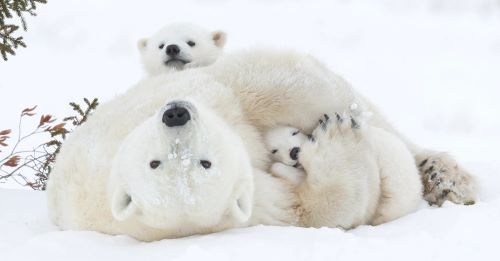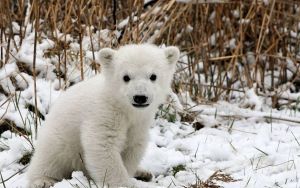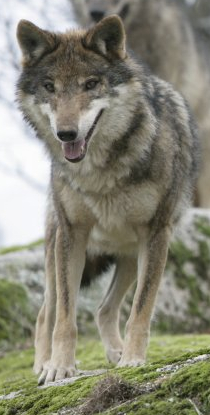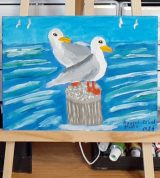Polar Bear Meets Progress…
Of Polar Bears. As the Water Rises, Their Prospects Fall.

THE POLAR BEAR: From Nanook of the North to Knut the Baby Polar Bear
You may have heard of Senator Nicole Eaton’s recent suggestion to re-designate Canada’s National Animal! From the industrious Beaver to the mighty Polar Bear. It’s a cultural change with which I heartily agree! The Polar Bear should be Canada’s National Animal. Polar Bears rock!
It’s only been three and a half centuries since Civilized Humans blundered their way into the high Arctic. Those few years have brought mass destruction not only to the polar bears themselves, but to the very world they live in. (For the very same reasons, the beloved Penguins of Antarctica are also facing brutal extinction).
From the early portrayals of savage Nanook (the native Inuit word for “Sea Bear”) to the latest protests by animal rights activists over the treatment of orphan polar bear cub Knut in the Berlin Zoo, our concepts of the giant white bear of the Arctic have changed.
Here, from Dr. Jeffrey Lant, is a stirring Guest Blog on our true National Animal:
“Of Polar Bears. As the Water Rises, Their Prospects Fall.“
What music is appropriate for the undoubted decline and possible demise of one of the grandest creatures on earth — Ursus maritimus — the Polar Bear?
I have selected Edvard Grieg’s 1867 masterpiece “From the Hall of the Mountain King.” This is the story of a race of kings, sovereigns all, ruling over a land of snow and ice. A land now melting, imperiling these princes of the North… whose prospects for survival wane as the sea waters around them rise, a rise which threatens human kind, too.
This is their story. We must heed it for they are not threatened alone. You’ll find Grieg’s suite in any search engine. Find it now… and listen to its evocative, enigmatic sound. This sound will endure…. but will the polar bears whose tale I tell this day?
The seas at the top of the world are rising, rising…
While politicians argue about cause and effect, the undeniable fact of global warming and rising seas is beyond cavil and dispute. Sea level has been rising significantly over the past century. This according to a newly released study that offers the most detailed look yet at the changes in ocean levels during the past 2,100 years.
Researcher Benjamin Horton is director of the Sea Level Research Laboratory at the University of Pennsylvania. Horton found that since the late 19th century — as the world’s industrialization intensified — sea level has risen more than 2 millimeters per year on average. That’s a bit less than one-tenth of an inch. A small amount that signals death for the Sea Bears. And chaos for seaside humans, drip by inexorable drip. It’s all about rising temperatures.
Rising sea levels are the hazards that deeply concern environmentalists and progressive governments. With increasing global temperatures caused by greenhouse gases like carbon dioxide from burning fossil fuels like coal and oil over the last century or so.
The heat generated works to steadily melt some of the millions of tons of ice piled up on land in Greenland, Antarctica, and elsewhere.
Such melting raises ocean levels and this, in turn, raises the possibility of major flooding in highly populated coastal cities and greater storm damage in oceanfront communities.
Polar bears must swim further and further for food…
Researcher Anthony Pagano is a US Geological Survey biologist at the International Bear Association Conference. Pagano has, in his newly released study, made it clear what happens to Ursus maritimus as the snow melts and the seas rise. He identified and studied 50 long-distance swims by adult female polar bears between 2004 and 2009 in the southern Beaufort and Chukchi seas.
“Climate change is pulling the sea ice out from under polar bears’ feet. Thus forcing some to swim longer distances to find food and habitat,” said Geoff York. York is a Sea Bear expert at the World Wildlife Fund who coauthored the study.
And the cubs simply fall off…
York said Sea Bears, tracked by satellite devices, routinely swim 10 miles or more for food. Their food is principally the seals they dote on and devour. But as the seas rise, these distances increase. Twenty bears in the survey swam more than 30 miles at a time. The longest-distance swim was 426 miles. The longest-lasting swim was 12.7 days, with a few brief breaks on drift ice.
All this is bad enough, but here’s the tragic element. Eleven of the bears that swam long distances had young cubs when researchers attached the tracking collars. Five of those mothers lost their cubs while swimming… and thus the breed and its prospects are diminished…
Facts about the threatened polar bear, majestic, now vulnerable.

The polar bear, universally admired, is the world’s largest land carnivore. And also the largest bear, together with the omnivorous Kodiak bear, which is approximately the same size. An adult male weighs around 350-680 kg (770-1,500 lb). While an adult female is about half the size.
Although it is closely related to the brown bear, it has evolved to occupy a narrower ecological niche. With many body characteristics adapted for cold temperatures. For moving across snow, ice, and open water. And for hunting the seals, which make up most of its diet.
The polar bear is classified as a vulnerable species, with eight of the 19 polar bear subpopulations in decline. Researchers estimate there are 20,000 to 25,000 polar bears worldwide; they are listed as threatened under the US Endangered Species Act.
“Nanook of the North.” – Iconic Polar Bear
The polar bear has evolved over the course of uncounted centuries. Forming an intricate, necessary symbiosis between the polar elements, the polar bear and Inuit and other indigenous peoples of the North have slowly, carefully evolved together. The Northern people revered the bear whose flesh they enjoyed. They called the polar bear “Nanook” — and took the name proudly for themselves.
In 1922, Robert J. Flaherty released one of the first — and most celebrated — documentaries of the silent film era, Nanook of the North. He called it “A Story of Life and Love In the Actual Arctic.” In the tradition of what would later be called “salvage ethnography,” Flaherty captured (and some critics said staged) the struggles of the Inuk Nanook and his family in the Arctic region of Northern Quebec.
Nanook of the North was released in 1922 to worldwide acclaim. In his honour, the Government of Canada named an island in the Hudson Bay “Flaherty Island.”
In 1989, this French/Canadian film was one of the first 25 films selected for preservation in the United States Registry by the Library of Congress as being “culturally, historically, or aesthetically significant.”
But the human Nanook, though most assuredly a predator of the ursine Nanook, was never a problem, for he took only what he needed…
…and was never wanton. He never forgot he needed Nanook. No, he is not the problem, though Humankind as a whole most assuredly is. For we as a genus are thoughtless, careless, always anxious to shift the guilt, the burden, the responsibility to others for what we have done.
The Bear Facts
And what’s terrible about this so sad situation is this. We know what to do and when and how to do it. We don’t need more learned studies; for studies about the future of Ursus maritimus and its irrevocably changing environment are frequent, thorough, detailed, and unanswerable. Action is needed… before this matter becomes, like the histories of so many other species, academic.
But, for now, let us end as we began, with Edvard Grieg, master of unsurpassed, haunting melody. A creature of the North, knowing Winter well, he cherished the fleeting glories of Spring. In this spirit, he composed something so beautiful it is painful to listen to. He called it “Last Spring”, and you must go to any search engine now to play it.
Let it fill your heart with compassion for the great creatures now completely at the mercy of their greatest predators, us. Let us pray that this song of soul by Grieg remains great music only and that there is no “Last Spring” for Ursus maritimus, beloved of man, dying through the works of man.
For where shall we find your like again; You who thrilled us so?
Where shall we look when you are gone you who have been made by God?
When you are gone who will care for why when your great heart beats no more?
God will know…… but He will not say for we who were bade to cherish failed you.
So now we lament… too late Now we shall know you not and nevermore.
Never to play again under the great Northern Lights once your heaven.
Where then have you gone? You whom we loved, and failed…
– Dr. Jeffrey Lant. Jeffrey Lant received his M.A. & Ph.D. in History from Harvard University. He published over 60 books on subjects from Animal Rights to Marketing. Said Dr. Lant, “I’ve been blessed in my life. No question about it. But, as Browning said, ‘the best is yet to come.’ That’s why EVERY morning, I’m up early, ready to dig into my email and see who I can help today…” See Dr. Jeffrey Lant Associates.
==>> And you’ve got to see my controversial post What is Canada’s National Animal? The Polar Bear!
 Do you love wild animal tales?
Do you love wild animal tales?
IF SO, YOU’LL LUV “WOLFBLOOD” — MY MOST POPULAR ANIMAL STORY: “HAPPY ENDING!”
“I JUST READ WOLFBLOOD AGAIN FOR GOOD MEASURE. ONE FOR ANY WOLF LOVER. ENJOYED IT BUT WISH IT WAS A FULL LENGTH NOVEL.” – Gina Chronowicz @ginachron
“THIS WAS A GREAT SHORT STORY. MORE PLEASE!” Make It Beautiful @Create4Ever
WOLFBLOOD, a Northwestern yarn in the Jack London Tradition, Free to Read ==> CLICK HERE WOLFBLOOD: A Wild Wolf, A Half-Wild Husky & A Wily Old Trapper
THE POLAR BEAR From Nanook of the North to Knut the Baby Polar Bear
What is Polar Bear Day? When is Polar Bear Day? International Polar Bear Day (IPBD) is held on every February 27th worldwide — an attempt to reveal the dire situation of our Polar Bears and their environment — and our continued attempt to save them.
==>> See Us on Our CELL PHONE FRIENDLY Format: BrianAlanBurhoe.com
The Polar Bear: From Nanook of the North to Knut the Baby Polar Bear.
Keywords: animal rights, Canadian, civilized bears, the polar bear, Knut, Kanook, baby polar bear, Knut polar bear, polar bears, endangered species, famous bears, penguins, polar bear facts.












